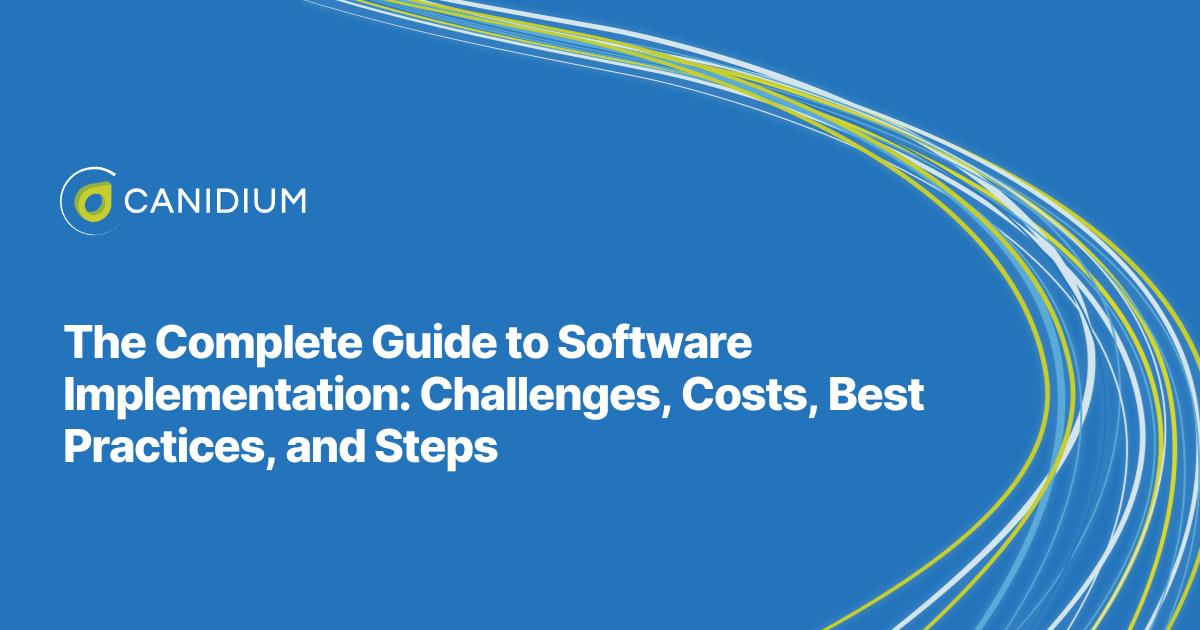Sales Performance Management (SPM) software implementation is a complex process that is vital to modern businesses' success. Rapid deployment of software solutions has gained popularity due to its competitive advantage.
What is rapid deployment?
Rapid software deployment refers to quickly deploying software applications or updates to production environments. It promises a shorter timeline, sometimes as little as eight weeks.
You may think, “My project isn’t that complex - a faster implementation makes sense for our case.” or “I want to implement and start getting results quickly.”
We hear you. Acknowledging the potential risks associated with speedy implementation is also essential. From our many years of experience, we think finding a balance between speed and stability is the key to success.
In this article, we will cover:
- Cons of rapid deployment
- Pros of rapid deployment
- What projects might be a good fit for rapid deployment
- What projects would not be a good fit for rapid deployment
Cons of rapid software deployment
Let’s delve into some of the most prevalent risks associated with rapid deployment in software implementation. When organizations prioritize speed over critical considerations such as requirements gathering, testing, change management, integration, scalability, and flexibility, they expose themselves to numerous pitfalls that can impact the project's success. Recognizing and addressing these risks is essential to ensure a smooth and successful software deployment process.
Inadequate Requirements Gathering
Rapid deployment often compels organizations to prioritize speed over comprehensive requirements gathering. Crucial user needs, business processes, and system functionalities may be overlooked when this happens. Insufficient requirements can lead to a software solution that fails to meet the organization's expectations, resulting in rework, additional costs, and customer dissatisfaction.
Limited Testing and Quality Assurance
Speedy software implementation can lead to insufficient testing and quality assurance procedures. Comprehensive testing is crucial to identify and rectify bugs, performance issues, and security vulnerabilities. Skipping or rushing through these crucial steps increases the likelihood of delivering a software solution that is unstable, unreliable, or prone to security breaches.
Ineffective Change Management
Rapid deployment often necessitates accelerated changes in business processes and workflows. Employees may struggle to adapt to the new software without proper change management practices, resulting in resistance, reduced productivity, and increased error rates. Effective change management strategies, including adequate training, communication, and user support, are essential to mitigate these risks and ensure a smooth transition.
Integration Challenges
Integrating new software with existing systems, databases, or infrastructure can be complex. Rapid deployment may not allow sufficient time for thorough integration testing, potentially leading to compatibility issues, data inconsistencies, or system failures. Inadequate integration can disrupt operations, cause data loss, and require additional resources to rectify the issues.
Insufficient Scalability and Flexibility
In pursuing rapid deployment, scalability and flexibility considerations may take a backseat. As businesses grow and evolve, their software requirements change. A hastily deployed solution may lack the scalability and flexibility needed to accommodate future growth, necessitating further development or system replacements, which can be costly and disruptive.
Pros of rapid deployment
Rapid deployment offers numerous benefits organizations can leverage to drive success in software implementation projects. By focusing on speed and agility, businesses can achieve faster time-to-market, enhanced adaptability, improved collaboration, risk mitigation, and continuous innovation. These advantages empower teams to respond quickly to market demands, deliver valuable products sooner, and stay ahead of the competition. Embracing rapid deployment as a strategic approach can lead to increased efficiency, productivity, and overall project success.
Faster Time to Market
One primary advantage of rapid deployment is the ability to bring software solutions to market faster. By streamlining development and deployment processes, organizations can reduce time-consuming bottlenecks and accelerate the delivery of valuable products or features. This speed enables businesses to capitalize on market opportunities swiftly, gain a competitive edge, and generate revenue sooner.
Enhanced Agility and Adaptability
Rapid deployment makes organizations more agile and responsive to changing business requirements and customer demands. This approach's iterative nature enables quick feedback loops, facilitating continuous improvements and adjustments. It empowers teams to iterate on features, gather user feedback, and make necessary enhancements promptly. This agility ensures that software solutions can effectively adapt to evolving business needs and customer expectations.
Improved Collaboration and Communication
The rapid deployment approach encourages close collaboration and communication among stakeholders, including developers, testers, project managers, and end-users. The iterative development cycles and frequent feedback loops foster transparent and regular interactions, leading to improved understanding, alignment, and shared ownership of the software implementation process. Enhanced collaboration enhances the quality of the final product and reduces the likelihood of miscommunication or misunderstandings.
Risk Mitigation through Early Validation
Rapid deployment promotes the early validation of software solutions through iterative testing and feedback gathering. By deploying smaller increments of functionality, organizations can identify potential issues or shortcomings early in the process. This approach allows for timely adjustments, reducing the risk of delivering a final product that fails to meet user expectations or business requirements. Early validation helps mitigate risks, minimize rework, and improve project success rates.
Continuous Innovation and Learning
Rapid deployment fosters a culture of continuous innovation and learning within organizations. The iterative nature of this approach encourages experimentation and exploration of new ideas. By frequently releasing software updates and features, organizations can gather valuable insights, learn from user behavior, and adapt their strategies accordingly. This continuous feedback loop promotes innovation, drives product enhancements, and ensures that software solutions remain relevant in a rapidly evolving market.
Is rapid deployment right for your project?
Rapid deployment in software implementation offers apparent benefits, but organizations must be mindful of the potential risks involved. By prioritizing speed over critical considerations such as requirements gathering, testing, change management, integration, scalability, and flexibility, businesses expose themselves to numerous pitfalls.
Projects that might be a good candidate for rapid deployment:
Small to Medium-Sized Projects
Rapid deployment is highly effective for small to medium-sized projects with a relatively limited scope and a shorter timeline.
Prototyping and Proof-of-Concept Projects
Rapid deployment can be an ideal approach to exploring new ideas or concepts. It enables teams to build quick prototypes or proof-of-concept solutions to validate assumptions, test feasibility, and gather user feedback.
Agile Development Methodologies
Projects that embrace agile development methodologies, such as Scrum or Kanban, are a natural fit for rapid deployment.
Internal Process Automation
Rapid deployment is well-suited for projects focused on automating internal processes and workflows within an organization. These projects typically involve streamlining existing processes or creating new systems to enhance efficiency, productivity, and cost-effectiveness.
Software Updates and Feature Enhancements
When it comes to updating existing software or adding new features, rapid deployment can be highly advantageous.
Startups and Proof-of-Value Initiatives
Startups and proof-of-value initiatives often operate in a dynamic and fast-paced environment, where speed to market and quick idea validation are crucial.
Projects that would not be a good fit for rapid deployment:
Large-Scale Enterprise Implementations
Projects involving large-scale enterprise software implementations, such as ERP (Enterprise Resource Planning) systems, CRM (Customer Relationship Management) platforms, or complex financial systems, are not ideal for rapid deployment.
Mission-Critical Systems
Projects that involve implementing mission-critical systems, such as those used in healthcare, aviation, or defense sectors, demand a cautious and risk-averse approach. These systems often have stringent regulatory requirements, reliability considerations, and potentially life-or-death implications.
Highly Regulated Industries
Projects in highly regulated industries, such as finance, healthcare, or government sectors, often require compliance with extensive regulatory frameworks. These projects involve stringent data privacy, security, and legal compliance requirements.
Projects with Extensive Third-Party Integrations
Rapid deployment may present challenges if a project heavily relies on integrating with numerous external systems, platforms, or third-party vendors. Integrations can introduce complexities, compatibility issues, and dependency management challenges.
Projects with High-Security Requirements
Projects that involve sensitive data, proprietary information, or advanced security measures require meticulous attention to security considerations.
Time to decide if rapid deployment is a good fit for you.
Striking a balance between speed and stability is crucial to mitigate these risks and ensure the successful implementation of software solutions that meet business objectives, user needs, and quality standards.
Since 2008, we have been executing all levels of software implementation for countless industries and use cases. We have seen it all. While articles like this can help you wrap your head around the concept of rapid deployment, you might not know what is right for you until you speak to people who have been doing this for a long time.
Please complete the form below to talk to Canidium about the appropriate deployment speed for your project.
Want to learn more about implementation timelines? Read this article on The Top 3 Pain Points in Software Implementation.








